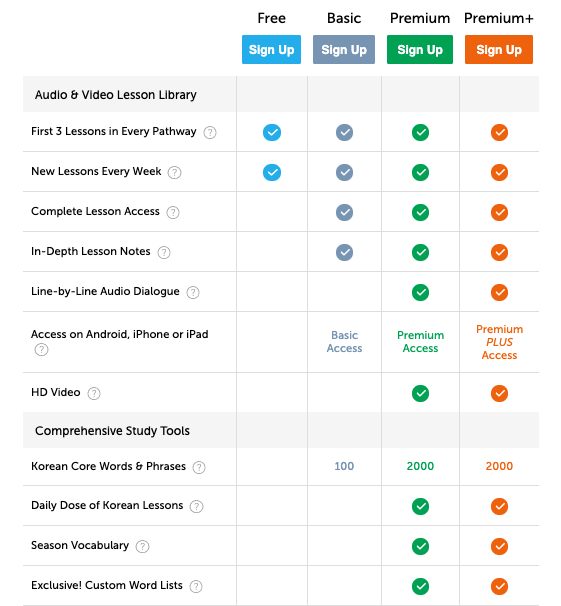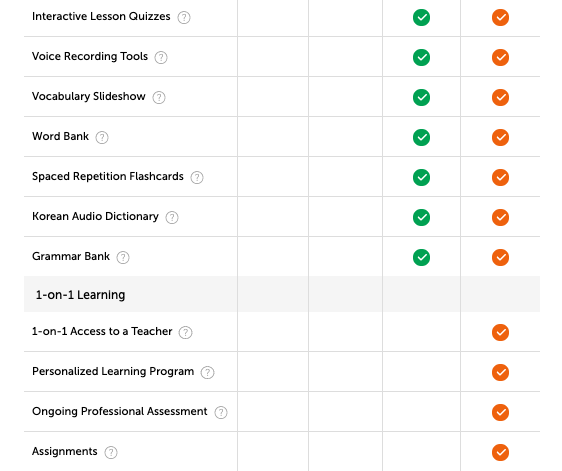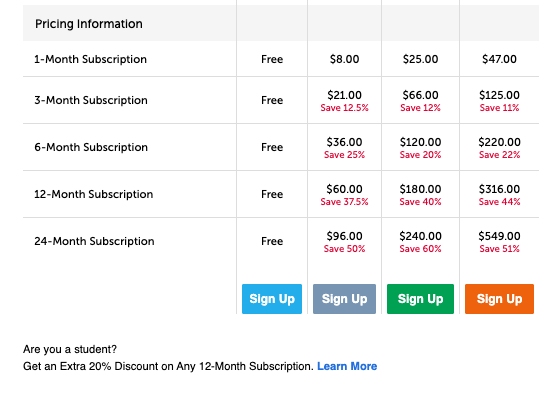Hey whatsup everyone! It’s been a busy start to the winter season for us, and we are looking to get back to posting regularly again from this week. We’ve also included some new goals in the types of infographics we want to make for you guys. We will go more into detail in an upcoming newsletter email so if you haven’t signed up for that yet, then put your name on our mailing list in the form on the sidebar or below the end of this post.
Today, we (Dom) will be reviewing and showing you guys a demo of one of the most popular online courses for learning Korean, the KoreanClass101 program. A lot of you may have seen or heard about this company from various blogs or videos, but may not know exactly what is in their members area after you choose one of their plans. So, we are going to show you from a first person view of what the members area is like.
I used them to start learning Korean years ago, and decided to purchase a one month subscription again recently to see how they have changed and what things they have added.
While KoreanClass101 offers lots of content from beginner to advanced, it would still be good to supplement it with other learning tools like books and applications. However, if you’re looking for a place where you can just conveniently login and find your lessons from any electronic device with an app, then it would be the best option on the market.
First things first. Yes, we have used this program. Not only just for this review, but this was the very first program Dom used to start learning Korean to go from beginner to intermediate. We only recommend learning tools here on the blog that we have used.
The written review is down below, and if you want to see the site in action, the video is right below:
With that said, let’s jump right into it!
Signing Up
Their biggest promotion comes from offering people the free 7-day trial which gives you access to free lessons every week, as well as the first 3 lessons of each series they have. Once you create an account, you can access new lessons every week until they put them into the members section (after 3 weeks).

This is a great way to test out their lessons and layout to see if you want to go for any of their paid plans after your free trial ends. You will need to submit your name and e-mail address or connect with your Facebook account to get free access. You will usually be sent offers from them to upgrade your plan as well as short lessons and short factoids about Korea and the Korean language. If the e-mails get too annoying, then you can just unsubscribe at any time.
You can also use the Innovative Language app to signup. This is one of the few programs to have a dedicated app to learning Korean, and most people love the program and the option to have an app:





Once you join, you will be taken to your dashboard where you can access all of your tools and lessons. For this review, I actually paid for the premium plus plan (1 month) which is the most expensive, so my dashboard will have more to offer than what you would see on the other plans plan. Let’s take a look:

Near the top, you will see your username and what type of plan you have. Next to that, you will also see the level you chose when you made you account (this can be changed at anytime). The levels go like so:
- Absolute beginner
- Beginner
- Intermediate
- Advanced
I found that for absolute beginners to intermediate, the content was actually quite useful. However for more advanced learners, there didn’t seem to as much as the lower levels.
Finally, you will see the number of lessons you completed, flashcards reviewed, and the number of hours you studied.
Below the top bar, you will see your pathways. These are basically topics for lessons that follow a certain theme or topic based on your level. We will get more into these further down below. As you move further down, you will see latest news, the newest lessons added to the website, and the newest vocabulary lists.
Finally, I want you to notice the circle with a person’s picture in the lower right hand corner. This is a chat box where you can talk and ask questions 1 on 1 with your own Korean teacher. This is only available in the premium plus plans, but it’s not something I would say you really need as it’s not a real 1 on 1 teaching situation (we will explain this later).
Pathways
Let’s get into the pathways we talked about earlier. In the screenshot we posted, you saw a pathway titled “Living in Korea”. If we click on that, we get taken to another area:

As you can see, this pathway contains 145 lessons which at a normal pace would take you around 17 hours to complete. There are also audio and video files for the lessons (you can see the icons for each individual lesson themselves).
As we said before, each pathway follows a certain topic and for beginners, this is the recommended pathway they start you off on. However you can freely go on any pathway you want. If you’re already past the beginner stage, you can skip these if need be. Let’s take a look at some other pathways outside of beginner in the intermediate level:

In this pathway, you can find a series of lessons designed to help you with reading and listening. Let’s take a look at the lesson called Earth’s Water. In it, you will find dialogue about water and it’s many uses.

You can read and follow along with the audio which is great for reading practice. You will also find the English and romanization options although we always recommend staying away from romanization. We kind of wish they didn’t add the romanization option for levels beyond absolute beginner as once you have learned the alphabet and can pronounce words, you won’t need it anymore and just makes things more confusing.
You also have the option of downloading the audio files as well as a PDF version of the lesson to your electronic device. One thing I’m disappointed in is the fact that although vocabulary lists are available for most lessons, for some of them, they are absent which is strange. For reading lessons, I feel that they could really help out a lot since context is important.
With that said, when the vocabulary lists are present, it’s really easy to add the to your word bank and flashcards.
There are many other pathways in each level and you can even sort them by topic like reading/writing, grammar, vocabulary, culture, and conversation.
Vocabulary
Next, we will be taking a look at the vocabulary section of your dashboard. You will find this tab at the top next to “lessons”.
Flashcards
The first section you will see is the flashcard section. I really like this section as it’s very customizable and easy to sort words you’ve been learning in previous lessons. Here, they start you off with a few decks that contain basic starter vocabulary.
However, you can go ahead and add your own words by simply clicking add new deck at the top:

Here in your deck manager, you can add words from different lists and lessons, although it can be a pain to sort through and find the words to add to your new deck. They did sort of make it easy by being able to sort by category, however I still think they could streamline this process a bit more. It would probably be easier to add words as you learn them in your lessons.
However even with that, once you get the words in the actual decks, you have the ability to review your cards and mark them correct if you’ve remembered them and incorrect if you haven’t.

Vocabulary Lists
Next, let’s take you to the vocabulary lists. Here you will find vocabulary sorted by topic to review and go over. Although there are filters such as sort by popularity, A-Z, and newest, it is hard to find exactly what you may be looking for. There is also a search function if you want to be more specific.

Although you can find some useful vocabulary and fun topics in these lists, I found this area a bit thin in terms of learning and preferred the vocabulary lists in the actual lessons themselves. This lists could be good for a quick study on the go as the topics are simple and easy to learn.
Word Bank
Here in your word bank, you can add words you are trying to learn to a list and you can export them for personal use outside of the website.

They can be exported as PDFs, Excel files, or XML and then can be printed off which is useful for writing quick notes down that may help you study the words. You will also find the lessons the words are featured in on the right. For more organization, you can also add your own personal labels and sync the words to your flashcards.
I found the wordbank to be the most organized part of the website.
Word of the Day
In the Word of the Day section, you will find a word for every day along with several example sentences using that word. I found this to be a pretty fun and simple way to act as a sort of warmup before jumping in to whatever lesson you are going to learn that day.

Korean Dictionary
One of the most useful tools you will find on the dashboard is the Korean dictionary. Here, you can search for any word, and it will give you the English definition along with the audio. This is great for when you want to quickly know the meaning of a word without digging through a paper book.
Extras
The final 3 things you will find in the vocabulary panel are the most common words and key phrases. These can get you off on the right foot for learning basic words and phrases that are used most frequently in basic conversation.
My Teacher
Finally, we will talk about the My Teacher portion of the website. This is only available with the Premium Plus plan and although marketed as having your own personal teacher, it’s more of having someone to give you weekly assignments and correct your work.
You can also take progressive assessment tests which they will grade and e-mail the results to you.
I really like the idea of a teacher for an online course, however it’s not really a one on one teaching situation like a personal tutor. I wouldn’t say this portion of the dashboard is that necessary for learning what you need to learn, however many people have said they found it useful.
Types of Plans
For our final section, we will get into the pricing for the different types of plans if you decide to continue your membership after your free 7 days.



Let’s break each one down:
Free
This plan allows you to sort of test drive a small portion of the members area for 7 days. Access to other features are limited, although you can get a good feel of how the lessons and basic tools are laid out.
Basic
One month plans start at $8 per month and go up if you want longer time for your membership. In this plan, you will get complete lesson access although you won’t have access to things like line by line audio, hd video, word bank, flashcards, word lists, or the dictionary.
Premium
One month plans start at $25 per month and go up if you want longer time for your membership. Here, you get complete access to the most useful tools of the website like the premium plan. The only thing added to this plan will be missing out on is the 1 on 1 teacher and personalized learning plan portion of the website.
Premium Plus
One month plans start at $47 and go up if you want longer time for your membership. Here, you get complete access to everything on the website.
If you complete your 7 day trial and like what you see, I think sticking to the premium plan works for most people, however everyone has different learning needs and preferences. Also, if you feel like you will be seriously putting your time into learning Korean for awhile, it is cheaper over time for a longer plan (they offer discounts for longer memberships).
Also note that if you can cancel anytime within 60 days and get your money back if you are not satisfied with them.
Final Verdict
When studying any language, it’s very rare that you will use one tool for the whole time you spend learning it. You will likely use a combination of books, websites, apps, and flashcards to help you reach your goal. I recommend sticking with 3-4 resources.
With that said, I think KoreanClass101 is absolutely great for beginners and intermediate learners as it offers lots of listening practice that is hard to find as well good vocabulary tools. As I said earlier, when I first came to Korea years ago, they were the first resource I used to get to a level where I could get around in Korea without feeling intimidated. After several months into my 2 year subscription, I did eventually supplement my learning with other great resources like Talk to me in Korean and books like Korean Grammar in Use to round out my knowledge.
The biggest cons for me were having to sort through many things in order to find what I was looking for, as well as not having more content for more advanced learners. I think that if they organized the content a bit better, it would make a huge difference.
The pros? First off, having a dedicated app to access lessons on my phone, great lesson notes with detailed explanations, the line by line audio dialogue, custom word lists, and the HD video. The presence of the app cannot be understated as it makes things so much quicker and easier when you’re on the go. I wish other Korean learning websites would do the same. Also, being able to record your voice as well as have ample listening practice is a huge plus that is hard to find on other websites.
So in the end, it’s just deciding whether or not the style of KoreanClass101 fits you and your budget and what you want to learn if you continue past the free 7 days. In terms of the other big players on the playground like TTMIK and 90 Day Korean, it all adds up anyways. TTMIK has great free content to get you a good foundation, but purchasing the books gets you to the real meaty content. (The one exception would be How to Study Korean. It mainly focuses on grammar and is a bit rough around the edges, but it is probably the best free resource that I know of.)
We hope you enjoyed this review, and feel free to ask us any questions by email if you have them. Cheers!
